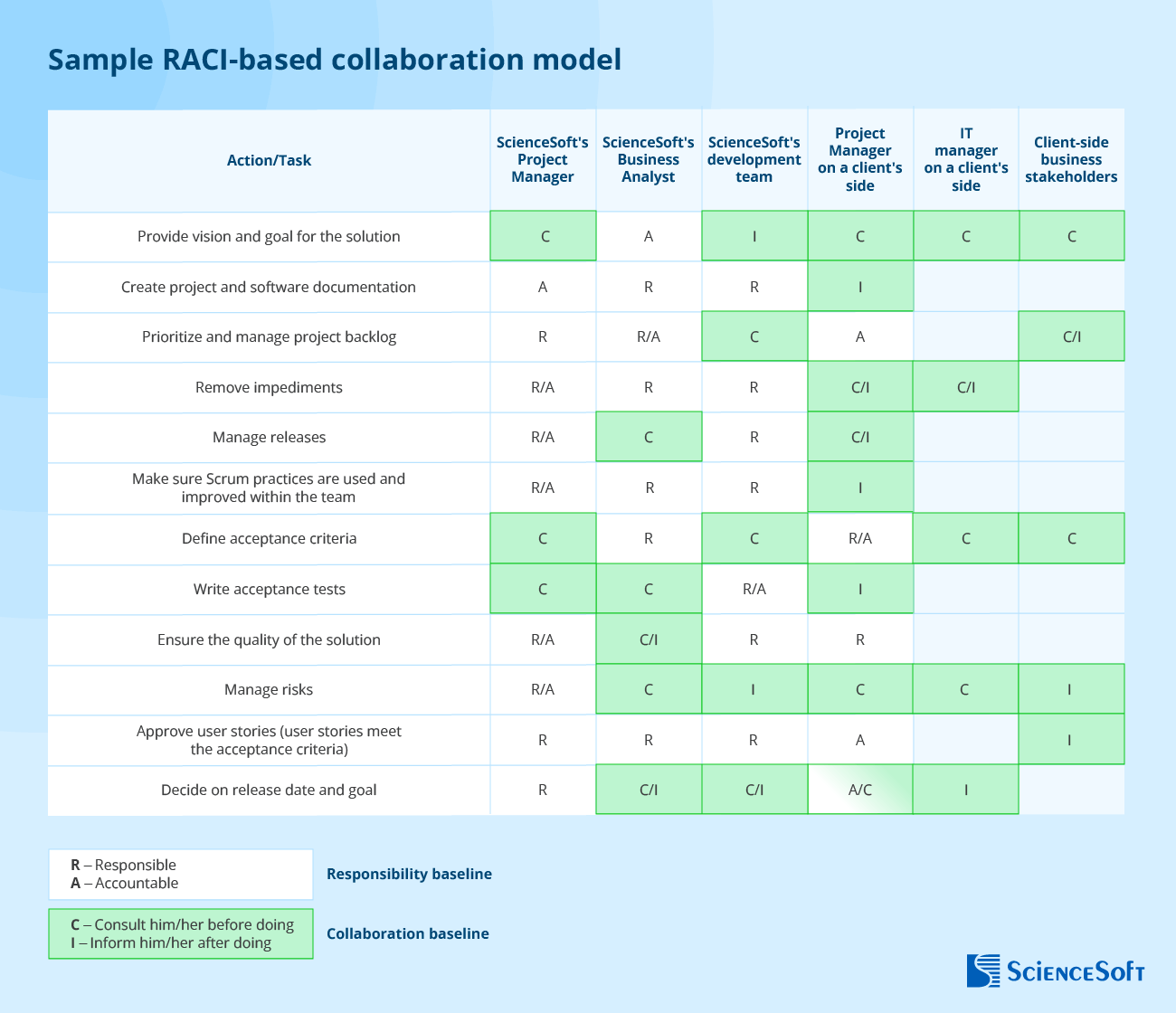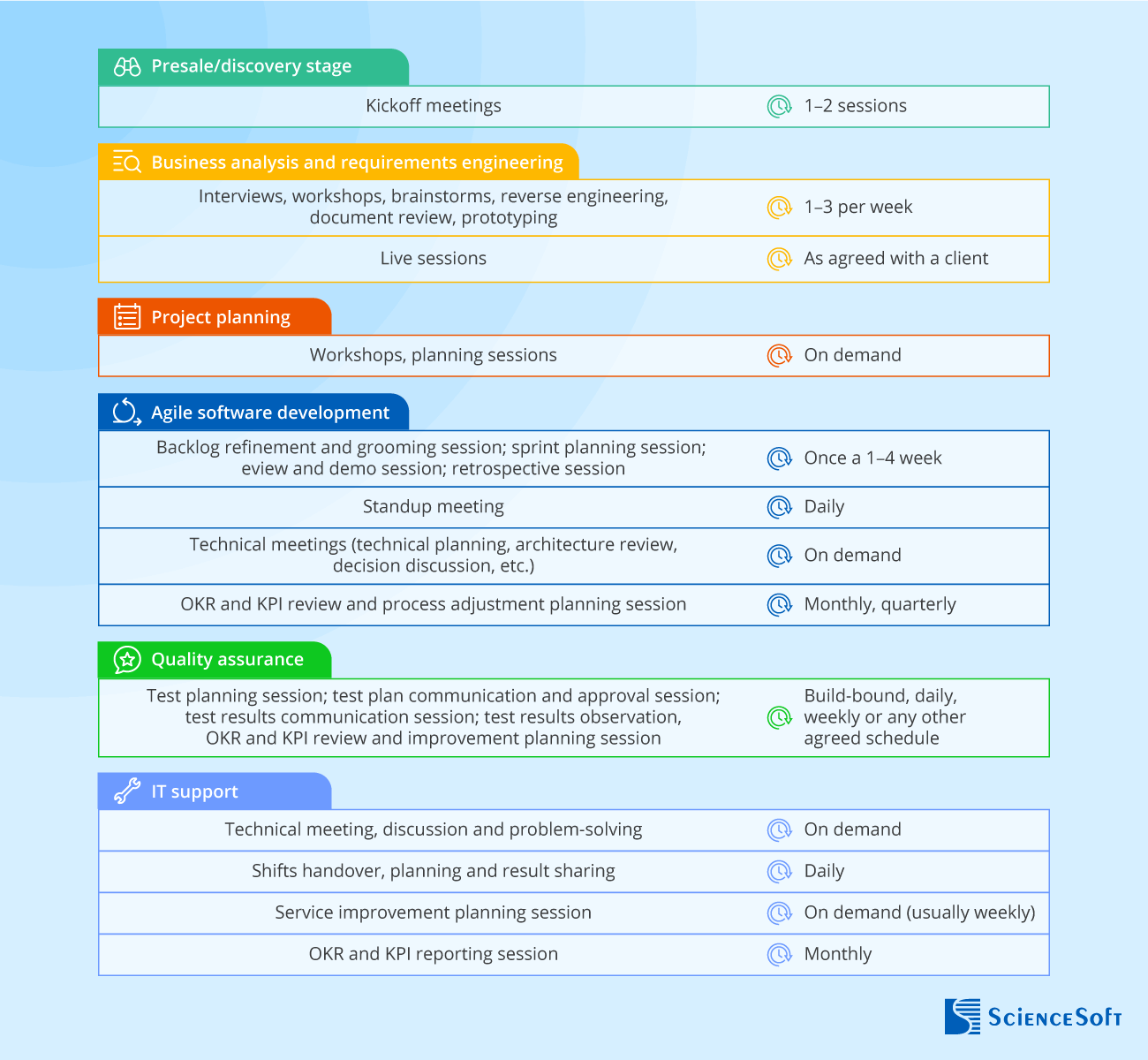ScienceSoft’s Practices for Effective Collaboration in IT Projects
A well-thought approach to collaboration is what differentiates a reliable tech partner able to deliver sustainable long-term value from an over-the-counter IT vendor focused on fast unilateral results. ScienceSoft’s mature collaborative culture helps us stand out amongst the competitors, flexibly address our clients’ evolving needs, and efficiently manage risks in a highly uncertain environment.
Collaboration in IT Projects: Summary
Having successfully completed over 4,000 IT projects, ScienceSoft knows that a flexible and involved approach is the key to establishing effective collaboration flows. And smooth collaboration is the backbone of meeting customer expectations regarding the project’s scope, time, and budget in the best possible way.
We offer tailored, individually-paced communication models for various IT services (development, QA, support, etc.), collaboration aspects (from daily communication to strategic alignment), and project stakeholders (from IT specialists to top management). Our engagements start with detailed collaboration planning at the strategic and tactical levels and involve the ongoing measurement of communication efficiency to resolve potential issues promptly.
Major Collaboration Challenges and Risks
IT vendors pursuing quick wins tend to overlook the value of close collaboration and maintain a detached approach to service delivery. Unwillingness to understand a client’s business, rigidity in communication modes, and non-disclosure of arising problems may result in service misalignment with the customer’s expectations and compromise project success.
A vendor’s failure to properly plan communication and promote joint efforts and knowledge sharing across all key project roles is another obstacle to sustainable collaboration. It results in communication gaps hampering productive teamwork, complicating change management and leading to budget overruns. In fact, a study by the Project Management Institute revealed that roughly a third of all failed IT initiatives collapse due to inadequate communication.
|
|
|
|
|
|
|
We at ScienceSoft believe that efficient collaboration propels long-term success and address its challenges with special attention. We maintain open, straightforward customer communication and cultivate the involved attitude toward our clients’ endeavors. Meticulous planning, transparency, flexibility, and continuous improvement are the four pillars of ScienceSoft’s collaborative approach, sharpened throughout 35 years in IT. |
|
|
|
|
|
|
|
Setting Up a Value-Driven Collaboration Process
Step 1. Collaboration flow planning
From the beginning of an engagement, ScienceSoft designs a plan of strategic communication activities and operational interaction flows. It helps ensure a steady cooperation start and reduce potential risks.
Here, we share a sample flow for an Agile software development project, where our project manager together with product owners, an account manager, business analysts, architects, and tech leads perform the following steps:
1. Identify the key business and development stakeholders on a client’s and ScienceSoft’s side.
2. Create a stakeholder matrix and communication plan and share the blueprint with all the involved parties. It helps ensure everyone is on the same page regarding the responsibilities and role-specific development aspects to collaborate on.
ScienceSoft’s sample RACI-based collaboration model for an Agile software development project looks as follows:

3. Make sure all key roles on ScienceSoft’s team obtain a unified vision of the customer’s as-is business situation and expected outcomes, which is essential to align development with the client’s short-term objectives and strategic goals.
4. Determine the required deliverables. It helps understand the major collaboration aspects and define their tangible outcomes.
5. Define the project scope and prioritize the scoped tasks based on their urgency, complexity, expected value for the client, and more. This step is crucial for the team leads to reveal the dependencies between the tasks and define the cross-team collaboration touchpoints.
6. Create the task schedule. It lays the basis for further granular planning of Scrum ceremonies and helps control the teamwork efficiency and progress pace.
7. Define the task owners and the team members’ functional responsibilities under particular tasks.
Step 2. Establishing tailored collaboration forms
ScienceSoft offers a wide spectrum of tactical collaboration forms for various IT services and collaboration models (outstaffing, a dedicated team, partial or full outsourcing). We tailor collaboration frequency and forms to meet our clients’ individual expectations.

Step 3. Selecting the collaboration toolkit
Reliable collaboration software lays the foundation for smooth, safe, and productive teamwork in the remote environment. Among the proven tools ScienceSoft recommends are:
Step 4. Evaluating the collaboration success
ScienceSoft continuously monitors collaboration efficiency based on tailored KPIs and promotes an open discussion within the teams and with clients. It helps timely spot potential issues and handle them before they negatively impact the IT service flow and decision-making speed.
- Our IT team leads regularly collect feedback from the team members to quickly get informed about the arising bottlenecks and precisely define the root cause of the workflow blockers.
- Our account manager and team leads keep in close touch with the decision-makers on a client’s side to stay up to date on any collaboration flaws that are out of tune with the customer’s goals and resolve issues in the best possible way.
Step 5. Ongoing collaboration improvement
ScienceSoft is not just another IT vendor relying on collaboration practices that are “good enough” to prevent barefaced conflicts and meet deadlines without budget leakage. We strive to have a truly meaningful impact on our clients’ gains and continuously improve collaboration throughout all levels of engagement. Based on our vision and customers’ needs, we may flexibly tune communication intensity and reporting frequency and involve our top management to handle strategic issues.









